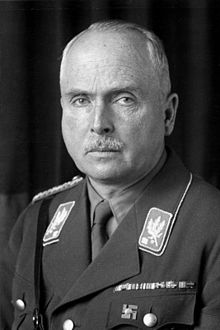| Charles Edward | |||||
|---|---|---|---|---|---|
| Duke of Albany | |||||
 Charles Edward in 1933 as SA-Gruppenführer | |||||
| Duke of Saxe-Coburg and Gotha | |||||
| Reign | 30 July 1900 – 14 November 1918 | ||||
| Predecessor | Alfred | ||||
| Successor | Monarchy abolished | ||||
| Regent | Ernst of Hohenlohe-Langenburg (1900 – 1905) | ||||
| Born | Prince Charles Edward, Duke of Albany 19 July 1884 Claremont, Surrey, England | ||||
| Died | 6 March 1954 (aged 69) Coburg, Bavaria, West Germany | ||||
| Spouse | |||||
| Issue | |||||
| |||||
| House | Saxe-Coburg and Gotha | ||||
| Father | Prince Leopold, Duke of Albany | ||||
| Mother | Princess Helena of Waldeck and Pyrmont | ||||
| Signature |  | ||||
| Military career | |||||
| Allegiance |
| ||||
| Service | |||||
| Rank | Colonel-in-Chief | ||||
| President of the German Red Cross | |||||
| In office 1 December 1933 – 1945 | |||||
| Preceded by | Joachim von Winterfeldt-Menkin | ||||
| Succeeded by | Otto Gessler | ||||
| Member of the Reichstag | |||||
| In office 1936–1945 | |||||
| Personal details | |||||
| Political party | Nazi (1933 – 1945) | ||||
Charles Edward (Leopold Charles Edward George Albert;[note 1] 19 July 1884 – 6 March 1954) was at various points in his life a British prince, a German duke, and a Nazi politician. He was the last ruling duke of Saxe-Coburg and Gotha, a state of the German Empire, from 30 July 1900 to 14 November 1918. He was later given multiple positions in the Nazi regime, including leader of the German Red Cross, and acted as an unofficial diplomat for the German government.
Charles Edward's parents were Prince Leopold, Duke of Albany, and Princess Helen of Waldeck and Pyrmont. His paternal grandparents were Queen Victoria of the United Kingdom and Prince Albert of Saxe-Coburg and Gotha. Prince Leopold died before his son's birth. Charles Edward was born in Surrey, England, and brought up as a British prince. He was a sickly child who developed a close relationship with his grandmother and his only sibling, Alice. He was privately educated, including at Eton College. In 1899, Charles Edward was selected to succeed to the throne of Saxe-Coburg and Gotha because he was deemed young enough to be re-educated as a German. He moved to Germany at the age of 15. Between 1899 and 1905, he was put through various forms of education, guided by his cousin, German Emperor Wilhelm II.
Charles Edward ascended the ducal throne in 1900 but reigned through a regency until 1905. In 1905, he married Princess Victoria Adelaide of Schleswig-Holstein. The couple had five children, including Sibylla, the mother of King Carl XVI Gustaf of Sweden. The Duke was a conservative ruler with an interest in art and technology. He tried to emphasise his loyalty to his adopted country through various symbolic gestures. Still, his continued close association with the United Kingdom was off-putting both to his subjects and to the German elite. He chose to support the German Empire during the First World War. He had a disability and assisted the Imperial German Army without participating in combat. He was deposed during the German Revolution like the other German princes. He also lost his British titles as a result of his decision to side against the British Empire.
During the 1920s, Charles Edward became a moral and financial supporter of violent far-right paramilitary groups in Germany. By the early 1930s, he was supporting the Nazi Party and joined it in 1933. He helped to promote eugenicist ideas which provided a basis for the murder of many disabled people. He was involved in attempting to shift opinion among the British upper class in a more pro-German direction. His attitudes became more pro-Nazi during the Second World War, though it is unclear how much of a political role he played. After the war, he was interned for a period and was given a minor conviction by a denazification court. He died of cancer in 1954.
- ^ Urbach 2017, p. 30.
Cite error: There are <ref group=note> tags on this page, but the references will not show without a {{reflist|group=note}} template (see the help page).